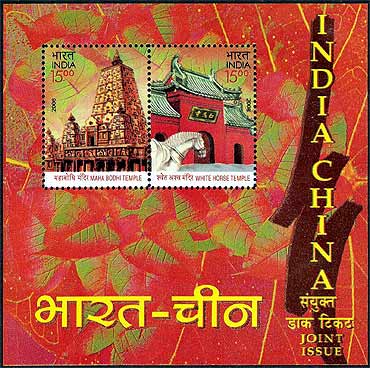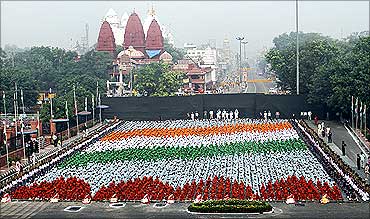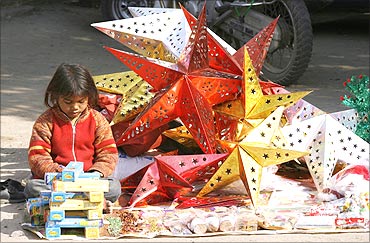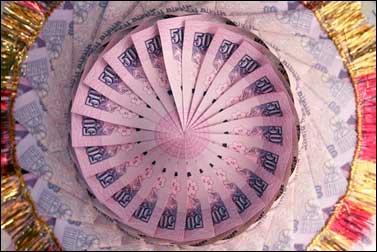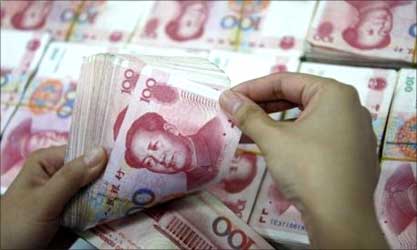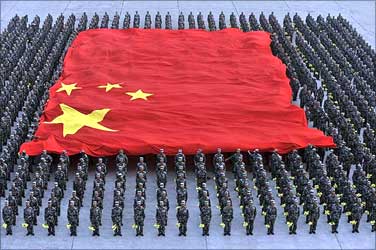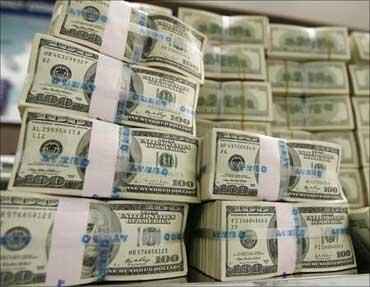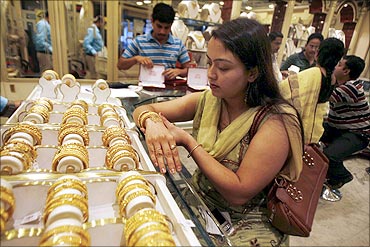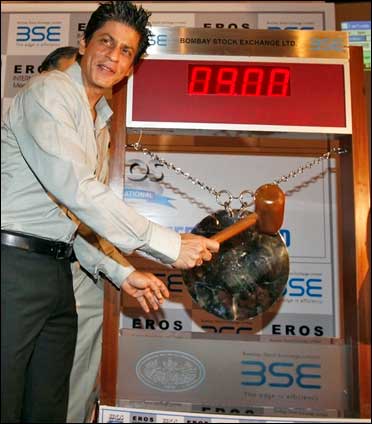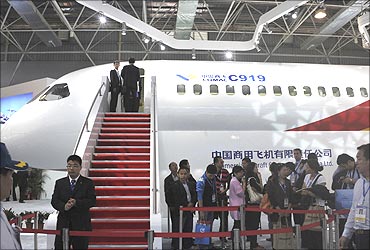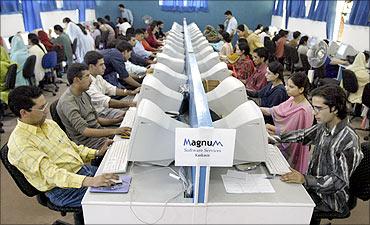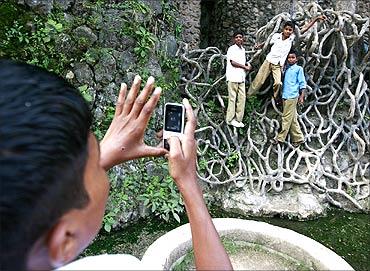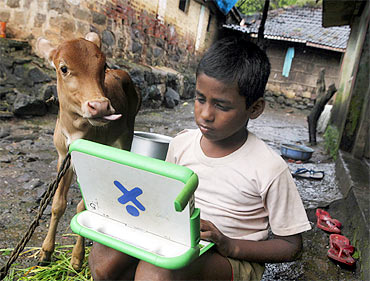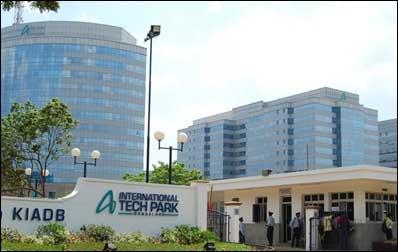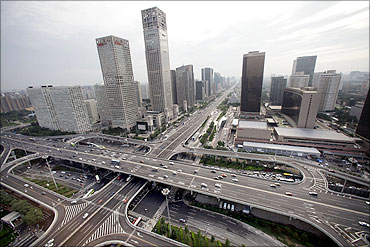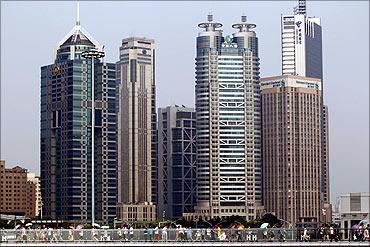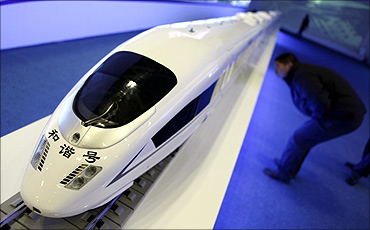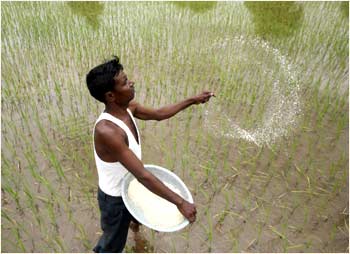 | « Back to article | Print this article |
Stats don't lie! China way ahead of India
 The rise of the fastest growing economies of China and India has taken the world by surprise. Post-recession, while developed countries continue to struggle, the India-China growth story still seems to be intact.
The rise of the fastest growing economies of China and India has taken the world by surprise. Post-recession, while developed countries continue to struggle, the India-China growth story still seems to be intact. As China surges ahead as an economic superpower, here's a look at how the two economic giants score on various growth parameters.
ECONOMY
China
This year China became the world's second largest economy, surpassing Japan. China's economy was valued at $4,98 trillion in the second quarter of 2010.
China could become the world's largest economy (by nominal GDP) by 2020.
India
The Indian economy is the eleventh largest in the world, valued at $1.23 trillion by nominal GDP and the fourth largest by purchasing power parity (PPP).
Click NEXT to read on . . .
India vs China: An economic battle
 ECONOMIC GROWTH
ECONOMIC GROWTH India
India is poised to achieve the 9 per cent economic growth in the current financial year itself, driven by the robust performance of agriculture and industry sectors.
The economy grew by 8.9 per cent in the second quarter of the current fiscal.
China
In the first three quarters of this year, China's GDP grew by over 10 per cent. The gross domestic product (GDP) grew 9.6 percent in the third quarter.
Click NEXT to read on . . .
India vs China: An economic battle
 GDP Per capita
GDP Per capita China
With a GDP (PPP) per capita of $6,778, China is ranked at 97. Today, about 10 per cent of the Chinese population (down from 64 per cent in 1978) live below the poverty line of $1 per day (PPP). Inflation stands at 4.40 per cent.
Moreover, Hong Kong has a GDP (PPP) per capita of $42,653.
IndiaIndia with a per capita GDP of $3,015 has one of the lowest ranks at 127, according to the International Monetary Fund.
Inflation currently stands at 9.82 per cent.Around 70 crore (700 million) Indians live on $2 per day or less, but there is a growing middle class population of about 30 crore (300 million) with a rising disposable income that is creating an unprecedented consumer boom in the country.
Click NEXT to read on . . .
India vs China: An economic battle
 ECONOMIC REFORMS
ECONOMIC REFORMS India
In the 1990s's India ushering in economic reforms that saw the country transform from a socialist economy to a market economy. The liberalization of the economy led to high economic growth and industrialsation.
China
In the 1970s, reforms called 'Four modernisations' improved agriculture, industry, technology and defence, heralding a fast pace of growth and rise in living standards.
In the 1990s, the Chinese economy continued to grow at a rapid pace, at around 9.5 per cent.
Click NEXT to read on . . .
India vs China: An economic battle
 FISCAL DEFICIT
FISCAL DEFICIT China
From January to October, China's fiscal revenue increased by 21.5 per cent year-on-year to nearly 7.09 trillion yuan.
IndiaIndia's fiscal deficit will be at around 5.5 per cent of its gross domestic product (GDP) in 2010-11. India's fiscal deficit has risen to Rs 4,12,307 crore (Rs 4.12 trillion).
Click NEXT to read on . . .
India vs China: An economic battle
 EXPORTS
EXPORTS China
China is also the largest exporter and second largest importer of goods in the world. China's exports jumped 34.9 per cent from a year earlier to $153.3 billion.
India India's exports during November jumped by 26.8 per cent to $18.9 billion year-on-year. India's exports during April-September aggregated to $103.65 billion registering a year-on-year growth of 28 per cent.Click NEXT to read on . . .
India vs China: An economic battle
 FOREIGN DIRECT INVESTMENT
FOREIGN DIRECT INVESTMENT China
China's continues to attract more foreign direct investment. The foreign direct investment volume in November jumped 38.2 percent year-on-year to $9.7 billion.
During the January-November period, FDI in China grew by 18 percent year-on-year to $91.7 billion, and was expected to exceed $100 billion by the end of 2010.
IndiaIndia, China and Brazil are the top three target countries for foreign direct investment until the end of 2012 with the United States, for years number one, now in fourth place, according to the UN Trade and Development Agency (UNCTAD).
Foreign direct investment inflows in to the country dipped by about 40 per cent to $1.4 billion in October over the same period last year.
In October 2009, FDI was $2.3 billion. During the first seven months of 2010-11, India received FDI inflows worth $12.40 billion.
Click NEXT to read on...
India vs China: An economic battle
 GOLD RESERVES
GOLD RESERVES China
According to the World Gold Council, the share of global gold demand in China doubled from 5 per cent in 2002 to 11 percent in 2009.
China has 1054.1 tonnes of gold, which is 1.5 per cent of its total foreign reserves.India
In 2009, total Indian gold demand reached $19 billion, or Rs 974 billion, which accounts for 15 per cent of the global gold market, according to WGC.
While Indian consumers continue to stock gold despite rising prices, when it comes to total gold reserves in the country, India ranks 11th in the world with 557.7 tonnes of gold.
Click NEXT to read on...
India vs China: An economic battle
 MANUFACTURING SECTOR China
MANUFACTURING SECTOR China China's manufacturing sector continues to grow with a booming consumer base in the country. China's manufacturing sector gained momentum in September with the Purchasing Managers Index rising to 53.8 in September from 51.7 in August 2010.
India
India has emerged as one of the world's top ten countries in industrial production. The nation's industrial production grew at the fastest pace in three months at 10.8 per cent. Manufacturing grew 11.3 per cent in October after a 4.6 per cent gain in September.
Click NEXT to read on...
India vs China: An economic battle
 UNEMPLOYMENT
UNEMPLOYMENT China
China, the world's second-largest economy after United States has a low unemployment rate of 4.20 per cent.
From 2002 until 2010, China's unemployment rate averaged 4.15 per cent reaching an historical high of 4.30 per cent in December of 2003.
India
Post-recession, the unemployment rate in India is at 9.4 per cent during 2009-10, according to the Union Labour and Employment Ministry.
About 40 million persons are unemployed in India as per the government's statistics.
The unemployment rates are estimated at 101 and 73 out of 1,000 persons in the rural sector and urban areas, respectively.
Click NEXT to read on
India vs China: An economic battle
 FOREX RESERVES
FOREX RESERVES China
The world's fastest growing economy, China saw its foreign exchange reserves rise to a record $2.65 trillion by the end of September 2010.
According to People's Bank of China, currency holdings rose about $194 billion.
China's trade surplus and inflows of cash from foreign direct investment also drive up the reserves, which rose 16.5 per cent by the end of September from a year earlier.
India
India's foreign exchange reserves grew by $2.41 billion during the week ended December 3 to $296.40 billion. Foreign currency assets rose by $1.98 billion to $267.23 billion during the week ended December 3, as per the data.
Click NEXT to read on . . .
India vs China: An economic battle
 PROSPERITY INDEX China
PROSPERITY INDEX China India has slipped 10 places to the 88th spot, way below China, in the World Prosperity Index due to poor healthcare and education systems coupled with a weak entrepreneurial infrastructure.
China is ranked 58th in the list of 110 countries according to London-based Legatum Institute's Prosperity Index 2010.
China ranks 30 places higher than India in the overall global rankings and outperforms India on the economy sub-index, where the Asia's second largest economy spots at 24th position.
India
India ranked low on education ground (89), health (95), entrepreneurship and opportunity (93) and social capital (105).Besides, economy (44th) and governance (41st) are two measures on which India ranks highest.
Click NEXT to read on . . .
India vs China: An economic battle
 STOCKS MARKETS
STOCKS MARKETS China
With two stock exchanges Shanghai Stock Exchange and Shenzhen Stock Exchange, China has become the world's third largest stock market. It is estimated to be the world's third largest by 2016.
India
The Bombay Stock Exchange has been rated as the world's best performing stock market recently. With a 13 per cent gain, Sensex is among the world's 10 biggest markets, according to data collected by Bloomberg.
Click NEXT to read on . . .
India vs China: An economic battle

AVIATION
China
Commercial Aircraft Corporation of China is set to take on world's biggest airline manufacturers Airbus and Boeing Co.
China's aviation industry has witnessed double-digit growth in the past five years. China's civil aviation fleet is set to nearly double to about 5,000 aircraft in five years.
IndiaIndia is yet to manufacture commercial aircraft though the aviation market is booming. India's civil aviation sector will be among the top five in the world in the next five years.
Indian domestic air traffic is expected to reach 160-180 million passengers per year, while international traffic will exceed 80 million.
Click NEXT to read on
India vs China: An economic battle
 MAJOR CONTRIBUTORS TO GDP
MAJOR CONTRIBUTORS TO GDP China
The two most important sectors of the economy have traditionally been agriculture and industry, which together employ more than 70 per cent of the labour force and produce more than 60 percent of GDP.
India India's services sector, backed by the IT revolution, remains the biggest contributor to the country's GDP, with a contribution of 58.4 per cent. The industry sector contributed 24.1 per cent and the agriculture sector contributed 17.5 per cent to the GDP.Click NEXT to read on . . .
India vs China: An economic battle
 TELECOM REVOLUTION
TELECOM REVOLUTION China
China has 842 million mobile phone subscribers and 300 million fixed line phone subscribers.
India
The Indian telecommunications industry is the world's fastest growing telecommunications industry, 723.28 million telephone (landlines and mobile) subscribers and 687.71 million mobile phone connections as of September 30 2010.
Click NEXT to read on . . .
India vs China: An economic battle
 INTERNET USERS
INTERNET USERS China
Broadband Internet subscribers rose 19.19 million from end-2009 to hit 123.16 million. The telecom industry revenue generated total revenue of RMB 2.53 trillion ($382.34 billion) over the period, up 20.7 per cent year-on-year.
India
The number of Internet users in India is estimated at 81 million. The Telecom Regulatory Authority of India pegs the number of broadband subscribers at 10.08 million in August 2010. India will see its number of Internet users triple to 237 million by 2015.
Click NEXT to read on . . .
India vs China: An economic battle
 SPECIAL ECONOMIC ZONES
SPECIAL ECONOMIC ZONESChina
Special Economic Zones were born in China in the early 1980s. The most successful Special Economic Zone in China, Shenzhen, has developed from a small village into a city with a population over 10 million within 20 years.
India
India has also played a significant role in the founding and establishment of Special Economic Zones. Around 574 SEZs have already received formal approvals from the government, of which 350 have been notified under the SEZ Act. Currently, 105 SEZs are operational.
Click NEXT to read on . . .
India vs China: An economic battle
China
While 7 Indian cities are listed among the world's top 10 BPO, only one city from China, Shanghai is in the list.
China will have a 28.7 per cent share of the outsourcing industry globally. It will end the year with revenues worth $35.76 billion from the BPO sector alone.
China's IT services point out how exports last year amounted to only $9.6 billion. India, on the other hand, made $49.7 billion.
India
The Indian IT-BPO Industry is expected to exceed $70 billion in fiscal 2011. Indian IT-BPO exports are projected to grow by 13 per cent to 15 per cent while domestic IT-BPO will grow slightly more by 15 per cent to 17 per cent during fiscal 2011.
Click NEXT to read on . . .
India vs China: An economic battle
 Roads
Roads China
The total length of China's expressways is 65,065 km at the end of 2009. It has world's second longest after the United States.
Until 2015, the Chinese government will invest $600 billion (four trillion yuan) to develop high speed railroads, and fast railroads, and long-distance railroads. IndiaThe road ministry has unveiled an ambitious programme to construct 35,000 km of roads by March 2014 and has called for foreign investment to meet the financial requirements.
The highways ministry is keen to implement mega projects, each with a length of about 500 km and a total project cost of $500 million.
Click NEXT to read on . . .
India vs China: An economic battle
 COUNTRY BRAND
COUNTRY BRAND China
China was down to 56th position. Perceptions about political freedom, censorship battles with Google and the nation's handling of environmental issues were contributors to China's weak performance this year, the study said.
Russia, on the other hand, had to grapple with issues concerning both political freedom and corruption, the study said.
India
India is ranked 23rd in the Future Brands' annual country brand index, a comprehensive study of nations based on levels of awareness, familiarity, preference, consideration, advocacy and active decisions to visit.
India has slipped down five places from its perch in 2009, when it stood at 18th position.
Click NEXT to read on
India vs China: An economic battle
 RAILWAY
RAILWAY China
Aiming to break the 574.8 km/hour speed record set by France, China has signed agreements with Thailand and Laos to build high-speed railways.
On December 3, a high-speed passenger train manufactured by CSR Corporation hit a record speed of 486.1 km/hour on a test run on the Beijing-Shanghai line.Chinese railway officials said the CRH380A is designed to operate at a cruising speed of 380 kph, is the fastest train in operation in the world.
India
While China is conducting test-runs for one of the fastest trains in the world, Indian Railways are conducting a pre-feasibility study on running high-speed trains between Delhi and Agra and between Lucknow and Patna via Varanasi.
The study would seek to assess the feasibility of constructing high speed corridors on these routes, the route alignments and the ridership study among others.
Click NEXT to read on . . .
India vs China: An economic battle
 AUTO INDUSTRY
AUTO INDUSTRY China
In 2009, China beat Japan to become the largest automobile maker in the world, manufacturing 13.759 million vehicles.
The number of registered cars, buses, vans, and trucks on the road in China reached 62 million in 2009, and is expected to exceed 200 million by 2020.
The value of China's auto industry rose to 2.1 trillion yuan during the January-June period, up nearly 49 per cent from last year. China's automobile sales rose 26.9% in November.India
India is one largest and fastest growing auto markets. It manufactures over 11 million vehicles and exports about 1.5 million every year. It is also the world's second largest manufacturer of motorcycles.
By 2050, the country is expected to top the world in car volumes with approximately 611 million vehiclesIn November, car sales rose by 20.8 per cent in November to 161,497 units.
Click NEXT to read on . . .
India vs China: An economic battle
 STARTING A BUSINESS
STARTING A BUSINESS China
It takes 99 days for foreign companies to set up shop in China, says a World Bank report.
China has 18 procedures for foreign firms to fulfil. However, here it takes just 129 days for firms to access industrial land.
China lacks legal and regulatory transparency, according to the Index of Economic Freedom.
India
It takes as many as 46 days for a foreign company to set up business in India, but this is faster than in China.
India scores slightly better in terms of number of procedures (16) required for overseas firms to set up operations in the country.
However, it takes a whopping 295 days to lease public land in India.
Click NEXT to read on . . .
India vs China: An economic battle
 AGRICULTURE India
AGRICULTURE India India ranks second in farm output globally. India is the largest producer in the world of milk, cashew nuts, coconuts, tea, ginger, turmeric and black pepper.
China
China ranks first in worldwide farm output. The agriculture sector employs 300 million farmers. Only 15 per cent of its total land area can be cultivated.
